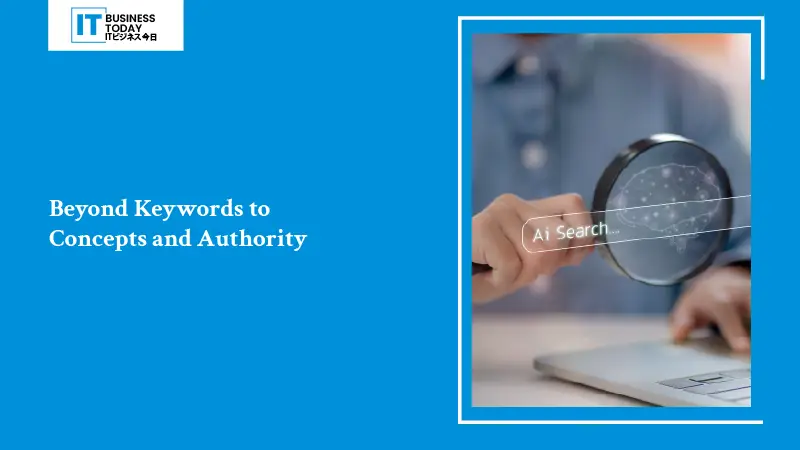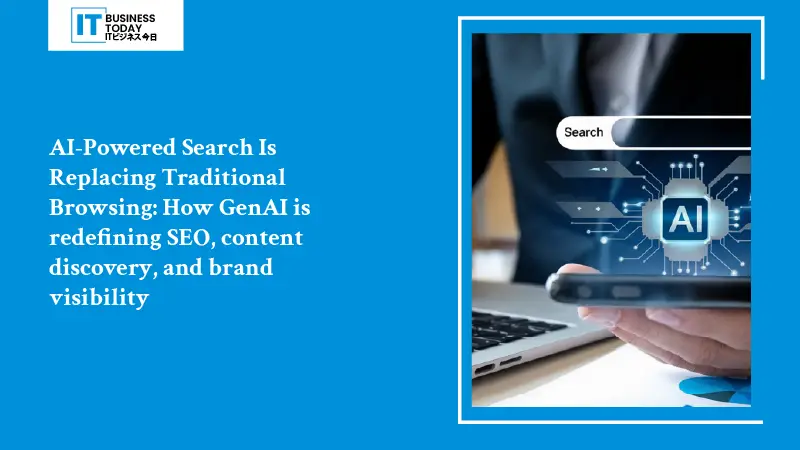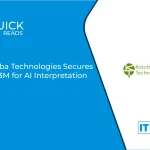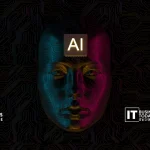何年もの間、オンラインで情報を探すのは簡単なことでした。キーワードを入力し、青いリンクをスキャンし、クリックし、閲覧し、絞り込み、その繰り返し。デジタルの世界をナビゲートするプロとして、私たちはこれをマスターしました。ウェブサイトを改善し、メタディスクリプションを作成し、ランキングを追求しました。1ページ目に表示されることが最高の勝利だと思っていたのです。大きな変化が起きています。小さなアルゴリズムの更新だけではありません。むしろ、検索インターフェースを完全に見直すことです。ジェネレーティブAIは、検索を強化するだけでなく、従来のブラウジングに取って代わりつつあります。グローバルブランドのビジネスリーダーにとって、この変化を理解することは重要です。それは単に先を行くということではなく、変化の激しいデジタル世界で生き残るということなのです。
ブルーリンクス時代の終焉
10本の青いリンクが並ぶ古典的な検索エンジンの結果ページ(SERP)は消えつつあります。AI検索エージェントの時代へようこそ。ChatGPT、Perplexity、Claudeなどです。また、Google検索やMicrosoft Bingの新機能にも注目してください。ユーザーが求めているのは、単なる情報源のリストではありません。ユーザーが求めているのは、明確で、直接的で、魅力的な答えなのです。あるユーザーはAIアシスタントに、『サプライチェーンの統合に重点を置く中堅製造業のために、CRMプラットフォームの上位3つを比較できますか?そして、主な違いの要約を求めます。AIは直接答えます。
この移行はユーザーの旅を根本的に変えます。AIはそれを簡単にします。もう複数のリンクをクリックする必要はありません。1つの詳細な応答で完全な回答が得られます。検索エンジンから始まっていた多くのジャーニーが、AIチャットで始まり、AIチャットで終わるのです。ゼロクリック検索」のステロイドの台頭と考えてください。によると ガートナーChatGPTやPerplexity AIのようなAIを搭載した検索エンジンに消費者がより依存するようになり、従来の検索量は2026年までに25%減少すると予測されています。
こちらもお読みください: IoTを活用した日本のスマートフォレストによる気候変動対策
キーワードから概念と権威へ

キーワードの密度、バックリンクのプロフィール、技術的な品質など、SEOの中核となる要素は依然として重要です。しかし、この新しい状況では、もはや十分ではありません。AIモデルが答えを出すとき、それは大量の情報を使用します。信頼でき、信用でき、関連性のあるソースに焦点を当てます。キーワードだけではありません。
このため、コンテンツ戦略の抜本的な転換が求められています:
- 意図が鍵:視聴者と真につながるには、彼らの主な質問を理解しましょう。彼らの検索の背景にある「理由」「方法」「比較」に焦点を当てましょう。コンテンツはこれらの具体的なニーズを満たし、キーワードにマッチするだけではありません。クラウドのセキュリティ機能」には焦点を当てないでください。ハイブリッド・クラウドを使用する金融サービス企業がゼロデイ脅威のリスクを低減し、コンプライアンスを維持するにはどうすればよいか」と問いかけましょう。
- E-E-A-Tブースト:Googleは現在、専門性、経験、権威性、信頼性をより重視しています。AIモデルは洗練された品質判定を行います。彼らは本当の専門知識を示すコンテンツを好みます。これは多くの場合、実体験や著者の強い信頼性から生まれます。信頼できる情報源を引用することも効果的です。さらに、深い分析は単純なリスト記事よりも優れています。デジタルトランスフォーメーション」に関する一般的なアドバイスと、CTOが書いたケーススタディの違いを見分けるAIを思い浮かべてください。このCTOは、あなたの業界でプロセスを成功に導きました。
- 構造化されたデータが鍵:AIがコンテンツの文脈や意味を把握するのに役立ちます。スキーマのマークアップとコンテンツの入念な構造化は、今や必ず行うべきSEOタスクです。これらはAIにとって重要な道しるべとなります。明確な見出し、定義されたセクション、整理された データ AIエージェントがあなたの情報を理解するのに役立ちます。そうすれば、正しく引用することができます。
- セマンティック検索とトピッククラスターの台頭: AIは文脈に沿って言語を理解します。成功するかどうかは、トピック・クラスターと呼ばれる強力なコンテンツ・エコシステムの構築にかかっています。これらのクラスタは、さまざまな角度からテーマをカバーし、トピックに関する深い知識を示します。これによりAIは、あなたのブランドがそのトピックに関する重要な情報源であることを伝えます。これにより、引用される可能性が高まります。ある調査によると、トピック・クラスター戦略によって、次のような驚異的な効果が得られたと報告されています。 97% オーガニック検索トラフィックの増加
コンテンツ・ディスカバリー
従来のブラウジングは、リンクをたどり、ブックマークされたサイトを訪れ、フィードをスクロールするなど、能動的な探索が必要でした。AIは、発見を高度にパーソナライズされた、しばしば受動的な体験に変えつつあります。AIエージェントと新しい検索プラットフォームは、ユーザーが必要としているものに基づいて情報を見つけます。過去のインタラクションやコンテキストを考慮します。多くの場合、ユーザーが検索する前に情報を提供します。
LinkedInのようなプラットフォームについて考えてみましょう。LinkedInはAIを使ってあなたのフィードに記事を提案します。これらの提案は、あなたの役割、興味、過去の活動から得られます。職場のAIアシスタントを思い浮かべてください。プロジェクトのメッセージをスキャンし、有用なリソースを提案します。ケーススタディ、競合分析、技術文書などです。すべて会社のナレッジベースから来ています。ソーシャルメディア、ニュースサイト、社内ツールの「フィード」は、専門家が見る情報を決定します。このアルゴリズムは、関連性とエンゲージメントに基づいてコンテンツを選びます。そのため、ブランドがユーザーに自然にリーチするのは難しい。コンテンツは、ユーザーが今何を必要としているかというAIの見解に沿ったものでなければなりません。ビジビリティとは、発見されることよりもそれよりも、特定のユーザーニーズにとって必要不可欠であるとアルゴリズムが判断することの方が重要なのです。最近の 研究 によると、AIパーソナライゼーションは、顧客エンゲージメント率を2倍、コンバージョン率を最大1.7倍高めることが報告されています。
ブランドの認知度
マーケターやビジネスリーダーにとって最も大きな混乱がここにあります。AIが直接的な答えを与えてくれる場合、ユーザーはしばしばソースサイトを訪れる理由がほとんどありません。時には、それをする簡単な方法さえないこともあります。あなたの入念に作られたコンテンツがAIの回答を後押しするのです。しかし、あなたのブランドは、ユーザーの目に触れることなく、脚注として終わってしまうかもしれません。
私たちは「サイテーション・エコノミー」に突入しています。ブランドの知名度は、トラフィックだけに依存するものではありません。それはまた、あなたの聴衆が必要とする答えのためにAIが頼るトップソースである必要があります。そのためには
- 比類なき権威:AIモデルによって、あなたの分野のトップソースとして認識されています。私たちは、新しいリサーチ、詳細な技術分析、ユニークなデータセットを定期的に共有することで、これを実現しています。当社の洞察は他ではなかなか得られません。業界ベンチマーク、大規模なサンプル数のオリジナル調査、先駆的な方法論などをご覧ください。
- プラットフォームとの直接リンク(ニューフロンティア):との直接的なつながりを模索しているブランドもあります。 AI プラットフォームで使用されています。Adobeが画像生成にChatGPTとFireflyを使用しているのは良い例です。貴社の技術文書は、エンタープライズAIアシスタントが簡単にアクセスできるように設定されていますか?製品データをAIインターフェース経由でシームレスに照会できますか?このようなパートナーシップを模索することが重要になるでしょう。
- ブランディング:AIの回答には必ずブランド名を入れてください。クリックは保証されませんが、役立ちます。コンテンツは、独自の視点、データ、ソリューションに焦点を当てるべきです。一般的な情報を再パッケージするだけでは不十分です。AIは、あなたの分析やデータが回答の差別化要因であることを理解しなければなりません。
- 新しいKPIの測定: オーガニック・トラフィック・ボリュームのような虚栄的な指標はあまり意味を持たなくなります。
新しい指標はこちら:
-
- AI出力におけるブランド言及の頻度と顕著性。
- AIが作成した主要トピックの要約における音声のシェア。
- AIエージェントによるブランドクエリ認識
- 直接の帰属がなくても、意思決定パイプラインへの影響力。
ビジネスリーダーのための戦略

移行期には、積極的で戦略的なリーダーシップが求められます。明確なベンチマークを待つことは、陳腐化の元です。ここでは、その方法をご紹介します:
- AI準備のための監査: 既存のコンテンツを厳しく評価しましょう。中核となるトピックについて、比類のない専門性と深さを示していますか?人間だけでなく、機械のために構成されていますか?ターゲットキーワードだけでなく、複雑な意図に基づいた質問に答えていますか?オーソリティを確立または強化する必要があるギャップを特定します。
- 量ではなく質を重視:多くの質の低いものから少数の優れたものにリソースをシフト。研究レポート、詳細なガイド、明確な結果を伴うケーススタディ、専門家による技術文書を探しましょう。人間もAIアルゴリズムも感心させる品質が新しい通貨です。
- チャンピオン E-E-A-T 組織全体: 専門性、経験、権威性、信頼性をブランド価値の中核に据えること。各分野の専門家がコンテンツを作成し、その名前を提供することを奨励します。顧客の成功事例を検証可能なデータとともに紹介。方法論について透明性を保つこと。これにより、AIモデルが求める信頼性が構築されます。
- 構造化データとナレッジグラフの探索:高度なスキーママークアップを使用するために技術チームと協力しましょう。内部ナレッジグラフの作成について考えてみましょう。あなたのドメインのエンティティ、関係、概念を定義することができます。これにより、AIがあなたの情報を理解し、正しく使用することが容易になります。これはAI時代の基盤となるインフラです。曰く グーグル開発者ブログ構造化データを使用しているウェブサイトでは、AIを利用した検索エクスペリエンスでの可視性が35%向上しています。
- AIのシーンを見る:AIチャットツールや新しい検索エンジンで、貴社のブランド、製品、主要トピックがどのように表示されるかを確認します。貴社の専門知識が引用されるべきなのに引用されていないクエリのタイプを分析します。これらの洞察を利用して、コンテンツやオーソリティ構築の取り組みを改善しましょう。AIの引用を追跡するのに役立つツールが登場しています。
- コンバージョン」を再考:クリック数が減少した場合、どのように関係を強化し、ビジネスの成果を高めることができますか?ゲーテッド・ウルトラ・プレミアム・コンテンツのような、AIの要約でお誘いする戦略を使いましょう。コミュニティを構築し、ユーザーが貴社を発見した後の個人的な育成ストリームにAIを使用します。AI認識により、ユーザーにシームレスなブランド体験をしてもらいましょう。
適応の必要性
AIを活用した検索エンジンの台頭は、遠い将来の予測ではなく、急速に進展しています。慣れ親しんだSEOとオーガニック・トラフィック獲得の世界は、取り返しのつかない変化を遂げつつあります。グローバルビジネスのリーダーは、引用経済で成功するために戦略を適応させなければなりません。つまり、ランキングを重視しないことです。その代わりに、あなたの分野でAIに認められた明確な権威になることを目指しましょう。そのためには、コンテンツへの強力な投資が必要です。信頼と専門性にコミットしなければなりません。また、知名度とエンゲージメントを向上させる新しい方法にも積極的に取り組んでください。
成功するブランドは、ジェネレーティブAIが単なる新しいツールではないことを認識するでしょう。それは、私たちが情報を見つけ、利用し、信頼する方法の完全なシフトです。受動的なブラウジングの時代は消えつつあります。インテリジェントな会話型回答エンジンの時代の到来です。迅速に行動するリーダーは、この新しい現実の最前線に自社ブランドを置くことになります。このシフトを生き残るだけでなく、次の章を切り開くのです。戦略的行動を起こすべき時は、紛れもなく今なのです。







